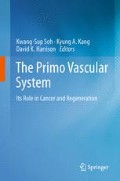Abstract
Tumor oxygenation is heterogeneous and severely compromised as compared to normal tissue. Hypoxia, i.e., oxygen depletion as a consequence of an imbalance between oxygen supply and cellular oxygen consumption, mostly results from inadequate diffusion and perfusion within tumors and from reduced O2 transport capacity in anemic patients. Detection of tumor hypoxia has been performed using minimally invasive approaches, imaging PET and MRI techniques, and immunohistochemistry on tissue biopsies. The development of tumor hypoxia is independent of a series of relevant tumor characteristics (e.g., clinical size, stage, histology, and grade) and various patient demographics. Overall median pO2 in cancers of the uterine cervix, head and neck, and breast is about 10 mmHg with the overall hypoxic fraction (pO2 ≤ 2.5 mmHg) being approximately 25%. Metastatic lesions do not substantially deviate from the oxygenation status of (their) primary tumors. Identification of tumor hypoxia may allow an assessment of a tumor’s potential to develop an aggressive phenotype or acquired treatment resistance, both of which lead to poor prognosis. Detection of hypoxia in the clinical setting may therefore be helpful in selecting high-risk patients for individual and/or more intensive treatment schedules.
Access this chapter
Tax calculation will be finalised at checkout
Purchases are for personal use only
References
Vaupel P, Kallinowski F, Okunieff P (1989) Blood flow, oxygen and nutrient supply, and metabolic microenvironment of human tumors: a review. Cancer Res 49:6449–6465
Vaupel P (2004) Tumor microenvironmental physiology and its implications for radiation oncology. Semin Radiat Oncol 14:198–206
Shchors K, Evan G (2007) Tumor angiogenesis: cause or consequence of cancer? Cancer Res 65:7059–7061
Vaupel P (2006) Abnormal vasculature and defective microcirculatory function in solid tumors. In: Siemann DW (ed) Vascular-targeted therapies in oncology. Wiley, Chichester, pp 9–29
Molls M, Vaupel P (eds) (2000) Blood perfusion and microenvironment of human tumors. Implications for clinical radiooncology. Springer, Berlin
Vaupel P, Mayer A, Höckel M (2004) Tumor hypoxia and malignant progression. Methods Enzymol 381:335–354
Vaupel P, Harrison L (2004) Tumor hypoxia: causative factors, compensatory mechanisms, and cellular response. Oncologist 9(suppl 5):4–9
Vaupel P (2009) Pathophysiology of solid tumors. In: Molls M, Vaupel P, Nieder C, Anscher MS (eds) The impact of tumor biology on cancer treatment and multidisciplinary strategies. Springer, Berlin, pp 51–92
Vaupel P, Höckel M, Mayer A (2007) Detection and characterization of tumor hypoxia using pO2 histography. Antioxid Redox Signal 9:1221–1235
Vaupel P (2004) The role of hypoxia-induced factors in tumor progression. Oncologist 9(suppl 5):10–17
Giaccia AJ (1996) Hypoxic stress proteins: survival of the fittest. Semin Radiat Oncol 6:46–58
Höckel M, Vaupel P (2001) Tumor hypoxia: definitions and current clinical, biologic and molecular aspects. J Natl Cancer Inst 93:266–276
Vaupel P (2009) Physiological mechanisms of treatment resistance. In: Molls M, Vaupel P, Nieder C, Anscher MS (eds) The impact of tumor biology on cancer treatment and multidisciplinary strategies. Springer, Berlin, pp 273–290
Acknowledgments
This work has been supported by a grant from the Deutsche Krebshilfe (106758).
Author information
Authors and Affiliations
Corresponding author
Editor information
Editors and Affiliations
Rights and permissions
Copyright information
© 2012 Springer Science+Business Media, LLC
About this paper
Cite this paper
Vaupel, P. (2012). Oxygen Transport to Tumors: Pathophysiology and Clinical Implications. In: Soh, KS., Kang, K., Harrison, D. (eds) The Primo Vascular System. Springer, New York, NY. https://doi.org/10.1007/978-1-4614-0601-3_29
Download citation
DOI: https://doi.org/10.1007/978-1-4614-0601-3_29
Published:
Publisher Name: Springer, New York, NY
Print ISBN: 978-1-4614-0600-6
Online ISBN: 978-1-4614-0601-3
eBook Packages: Biomedical and Life SciencesBiomedical and Life Sciences (R0)

